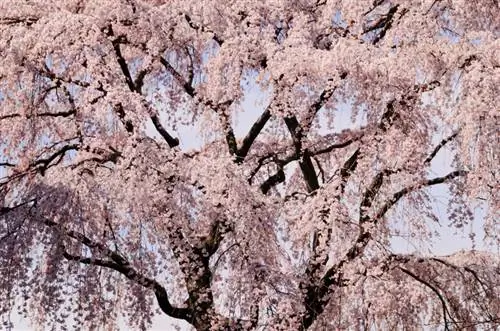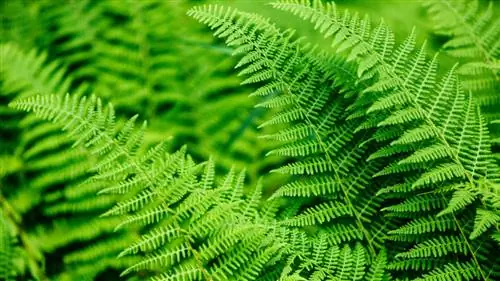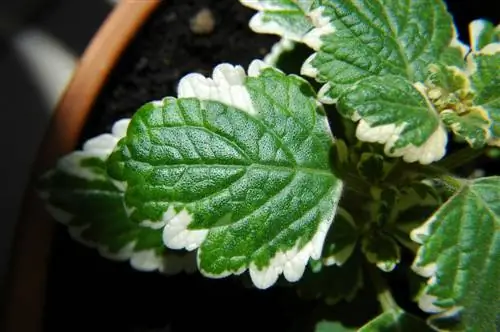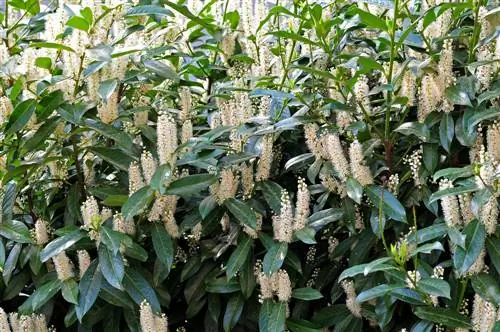- Author admin [email protected].
- Public 2023-12-16 16:46.
- Last modified 2025-10-04 22:19.
Read a commented profile about the laurel cherry here. Compact information about growth, leaves, flowering time and winter hardiness. You can find out how to properly plant and care for a cherry laurel hedge here.
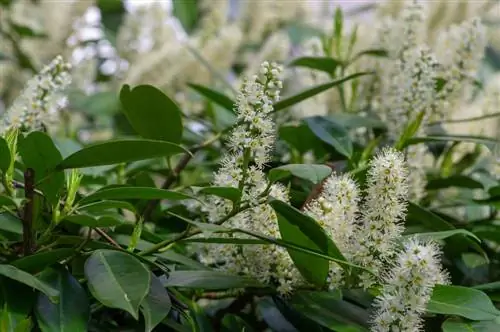
What should you know about the laurel cherry?
The cherry laurel (Prunus laurocerasus) is an evergreen shrub or tree that grows 2-4 meters high and is characterized by elongated, dark green leaves, white flower clusters and poisonous drupes. It is often used as a hedge plant, is easy to care for and hardy.
Profile
- Scientific name: Prunus laurocerasus
- Family: Rosaceae
- Synonym: cherry laurel
- Growth type: shrub or small tree
- Growth height: 200 cm to 400 cm
- Leaf: elongated, evergreen
- Flower: Grape
- Fruit: Drupe
- Roots: Heartroots
- Winter hardiness: hardy
- Toxicity: poisonous
- Use: hedge plant, solitaire, pot, ground cover
Growth
The laurel cherry is an evergreen shrub or tree from Asia Minor with all the attributes that hobby gardeners want from the perfect hedge plant. The ornamental tree from the rose family has impressive properties that make it easy to forget some of the disadvantages. The high popularity of cherry laurel in the gardens of Central Europe is explained by these key growth data:
- Growth characteristics: tightly upright, opaque foliage all year round, white flower clusters, black fruit decoration.
- Gardening advantages: hardy, easy to care for, robust, extremely compatible with cutting, fast growth.
- Gardening disadvantages: toxic, prone to invasive spread,
- Height: 2 m to 4 m in Central Europe, 3 m to 7 m in Asia Minor.
- Annual growth: 15 cm to 40 cm.
- Roots: Heart roots with long, strong roots deep and wide.
Video: Advantages and disadvantages of cherry laurel as a hedge plant
Leaf
The laurel cherry gets its name from the amazing similarity of its leaves to real laurel (Laurus nobilis). You can clearly recognize the leaf of Prunus laurocerasus by these features:
- Leaf shape: short-stalked, elongated-elliptical to obovate, pointed, smooth-edged.
- Leaf color: dark green-glossy, evergreen
- Leaf size: 5 cm to 15 cm long, 2 cm to 5 cm wide
- Leaf texture: leathery to coarse
A look at the leaf stalk confirms the close botanical relationship with bird cherry (Prunus avium). Two red honey glands are clearly visible there, which release sugar juice and exude a pleasant scent.
Bloom
In spring, the laurel cherry puts on a beautiful flower dress that, despite all the prophecies of doom, is eagerly swarmed by local insects. These characteristics characterize a cherry laurel blossom:
- Inflorescence: racemose, candle-shaped, 10 cm to 15 cm long, with numerous, five-fold individual flowers.
- Flower color: white petals, yellow pollen.
- Special feature: intensely scented.
- Flowering time: April to June
- flower ecology: hermaphrodite
- Pollinators: Insects, including bees, bumblebees and butterflies.
Pollinated flowers undergo a transformation into spherical, black cherries with a diameter of 10 mm to 12 mm by autumn.
Winter hardiness
The winter hardiness of the wild species Prunus laurocerasus reaches its limits early on in our latitudes. North of the Alps, the evergreen leaves have to pay tribute to the bitter cold and freeze back. Only since frost-hardy garden varieties began populating tree nurseries has the laurel cherry established itself as a popular hedge plant. Premium varieties such as Prunus laurocerasus Caucasica are certified to have a winter hardiness of -35° Celsius.
Usage
The laurel cherry shows its strengths not only as a hedge plant. The decorative shrub provides the best service in many ways. The following table lists functional and creative uses for cherry laurel in beds, on balconies and terraces:
| Beet | Balcony/Terrace |
|---|---|
| hedge plant | potted plant |
| Solitaire | Privacy protection |
| House tree alternative | Windbreak |
| Finding | flanking door guards |
| Groundcover | Box underplanting |
| Grave planting | Topiary tree |
The functions as a container plant, border or ground cover are fulfilled by garden-friendly varieties that have emerged from the wild laurel cherry. Magnificent cherry laurel hedges are usually not made from the wild variety, but from successful hybrids with specific characteristics, such as extra large leaves or a columnar silhouette.
Excursus
Laurel cherry - poisonous to humans and animals
The laurel cherry is poisonous in all parts. The focus is on seeds with a high content of prunasin, a toxic glycoside. Chewed seeds turn into hydrogen cyanide in the stomach with fatal symptoms of poisoning, including respiratory and cardiac arrest. Leaves and pulp are only moderately poisonous. The good news is that no one can bite the rock-hard cherry stones, especially not children or pets. Kernels that are swallowed whole are simply excreted along with the poison.
Planting cherry laurel
Before planting cherry laurel hedges, gardening newcomers have many questions about location, planting time and planting technique. Read on here, because the good-natured laurel cherry has a simple answer to every question.
Which cherry laurel location?
These are the most important parameters for the right location:
- Sun to shade (ideally partial shade).
- Protected from the wind.
- Normal garden soil, preferably loamy, fresh to moist, humus and nutrient-rich.
- Exclusion criterion: waterlogging
When choosing a location, please also consider the legal distance to the property line or coordinate with your neighbor beforehand.
When to plant cherry laurel?
You can buy laurel cherries in tree nurseries as containers or bales. This quality allows year-round planting. The recommended planting time is in spring so that the young rose plants have strong roots by winter. A second window for planting opens in autumn. Saving hunters have to wait until October because at this time there are inexpensive bare-root shrubs to be had in well-stocked tree nurseries.
Cherry laurel hedge - how to plant?
As part of the soil preparation, you are spared the hassle of removing all root residue. The laurel cherry is a competitive root conqueror. Only the thickest tree roots have to give way so that the spade can get into the ground for excavating planting pits. The following short instructions explain how to properly plant a cherry laurel hedge:
- Place each young bush with root ball in a bucket of water.
- Measure the hedge and mark it with stretched strings for a straight course.
- Dig planting holes with twice the diameter of the root balls.
- Planting distance: 30 cm to 50 cm, depending on the variety and desired privacy protection quality.
- Extra tip: mix half of the excavation with compost and horn shavings.
- Plant laurel cherries, tamp down the soil and slurry it in.
In the last step of planting the hedge, mulch the root slices with leaves or bark mulch. Drought stress is the most common cause when cherry laurel hedges fail to grow. In the first few days and weeks, go to the hedge regularly to water every bush.
Care for cherry laurel
The laurel cherry is extremely easy to care for. Watering, fertilizing, cutting and propagating are easy for you if you follow these care tips:
Pouring
The rapid, dense growth of a laurel cherry does not depend on excessive watering. A competent water balance aims to avoid drought stress and waterlogging. Because evergreen cherry laurels evaporate water at all times of the year, the water supply continues at a economical level even in winter. Which irrigation water you use is up to you. The rose family tolerates normal tap water, skimmed pond water and collected rainwater.
Fertilize
The laurel cherry thanks for a supply of nutrients twice a year with strong, densely bushy growth, lush flowering and robust winter hardiness. At the end of March, spread 3 to 5 liters of compost per square meter under a laurel cherry, rake in the organic fertilizer superficially and water again. At the end of August, give cherry laurel a hedge, shrub or tree a potassium-rich fertilizer, such as Patentkali (€33.00 on Amazon) or comfrey manure.
Cutting
There is a detailed tutorial dedicated to the correct pruning of bay cherries, which you can read here. All important aspects in a nutshell:
- Pruning dates: Prune cherry laurel in spring (mid/end of February) or summer (end of June).
- Plant pruning: after planting, cut back all shoots by a third or half.
- Build-up cut: cut to the desired final height twice a year in February and June.
- Maintenance pruning: thin out in late winter, cut back last year's growth, shorten branches that protrude out of shape in June.
- Cutting guide: Place the hand scissors a few millimeters above an outward-facing blade.
- Important: Cut the laurel cherry hedge into a trapezoid shape (wide base, narrow crown).
It is best to use hand hedge trimmers. Electric hedge trimmers shred the beautiful, large leaves at the expense of a well-groomed appearance. With very large cherry laurel hedges, hobby gardeners accept this disadvantage because the damaged laurel leaves quickly become overgrown.
Propagate
The easiest way to propagate the laurel cherry is through cuttings. As part of the pruning care, you will receive a we alth of suitable shoot tips as fast-growing head cuttings. How to do it correctly:
- Cut head cuttings 10 cm to 15 cm long.
- Defoliate the lower half of the cuttings.
- Halve the leaves in the upper half.
- Place two thirds of the bay cherry cuttings in the propagation box or pot into moist coconut soil.
- Water regularly in a warm, bright location.
A transparent cover creates a warm, humid microclimate that promotes rooting. Daily ventilation prevents mold from forming.
Diseases and pests
With its toxic ingredients, the laurel cherry successfully defends itself against diseases and pests. The evergreen shrub is not completely immune to pathogens. Cherry laurel hedges are also affected by the increasing number of unpredictable weather events caused by climate change. The following table provides an overview of common malfunctions, names the causes and gives tips for countermeasures:
| malicious image | Cause | What to do? |
|---|---|---|
| Yellow, brown spots, later holes | Shotgun disease | Pruning into he althy wood, horsetail spraying before flowering |
| White coating | Mildew | Cut off the affected area, inject milk-water solution |
| Semicircular bay feeder | Bigmouth Weevil | HM nematodes, neem, flower pot trap |
| Brown, dried leaves | Frost Damage | Pruning, from now on water on frost-free days |
Popular varieties
It is these premium varieties that helped Prunus laurocerasus achieve its breakthrough as the best-selling, evergreen hedge plant:
- Rotundifolia: dull-glossy, light green, large leaves, upright, dense growth, 2-4 m high, 1.2 to 2.5 m wide.
- Caucasica: tightly upright growth, dark green, shiny leaves, white, fragrant flower candles, height up to 350 cm.
- Herbergii: popular hedge plant, grows broadly upright to conical, well hardy, height 180 cm to 250 cm.
- Otto Luyken: grows wider, extremely frost hardy, ideal for low borders, growth height up to 150 cm, growth width up to 300 cm.
- Etna: impresses with the bronze-red shoots of the 12×5 cm large, rich green ornamental leaves, growth height 200-250 cm.
- Schipkaensis Macrophylla: large-leaved cherry laurel with 16×7 cm leaves, vigorous and well hardy.
FAQ
When can you plant cherry laurel?
In most tree nurseries you can buy cherry laurel in pots, containers or bales. The particular advantage of this cultivation is that it can be planted all year round, as long as the ground is not frozen, flooded or dried out. The best planting date is in spring so that the shrub from Asia Minor can prepare for the Central European winter. Another time window for planting opens at the end of August/beginning of September. For bare-root laurel cherries, the planting period extends from October to April.
How tall does cherry laurel grow?
In its native range from Asia Minor to the Balkans, cherry laurel grows up to 7 meters high. The evergreen shrub or tree does not achieve this height in our latitudes. Even vigorous garden varieties reach a maximum height of 4 meters outdoors.
Is the laurel cherry poisonous?
All parts of a laurel cherry plant are poisonous. The highest concentration of poison is in the seeds of the drupes. It is prunasin, a toxic glycoside. If this toxin enters the stomach, it is converted into hydrogen cyanide. However, the rock-hard seeds must be chewed and swallowed so that the toxins are released. Because it is almost impossible to crush the cherry stones, serious poisoning rarely occurs. The leaves and the dark pulp are slightly to moderately toxic when consumed raw. Cooked bay cherries without pits are not poisonous.
When does cherry laurel bloom?
The wild laurel cherry blooms from April to June. Most garden varieties bloom in May and June. If the weather conditions allow it and the cherry laurel is given a summer pruning, it will bloom again in autumn.
When should you fertilize the laurel cherry?
To properly fertilize a laurel cherry, provide the shrub with compost and horn shavings at the end of March/beginning of April. Further fertilization also strengthens winter hardiness. For this purpose, administer Patentkali at the end of August/beginning of September. Alternatively, shower the root slice with comfrey manure. The main nutrient potassium lowers the freezing point in cell water and strengthens the cell walls. This process makes plants particularly frost hardy.
Is the laurel cherry 'Otto Luyken' suitable for planting in a container?
Container storage is possible for every laurel cherry. The most important requirements are a sufficiently large planter and a regular supply of water and nutrients. Watering in dry conditions and monthly fertilization from April to July are mandatory. In view of the rapid growth, annual repotting into a larger container is recommended.
What planting distance should be maintained for a cherry laurel as a hedge?
If you give a laurel cherry hedge some time, a planting distance of 100 centimeters is sufficient. The privacy factor is achieved more quickly if you plant the bushes at a distance of 50 centimeters. For garden varieties with columnar growth, such as the laurel cherry 'Genolia', a planting distance of 30 centimeters has proven to be effective in practice.


